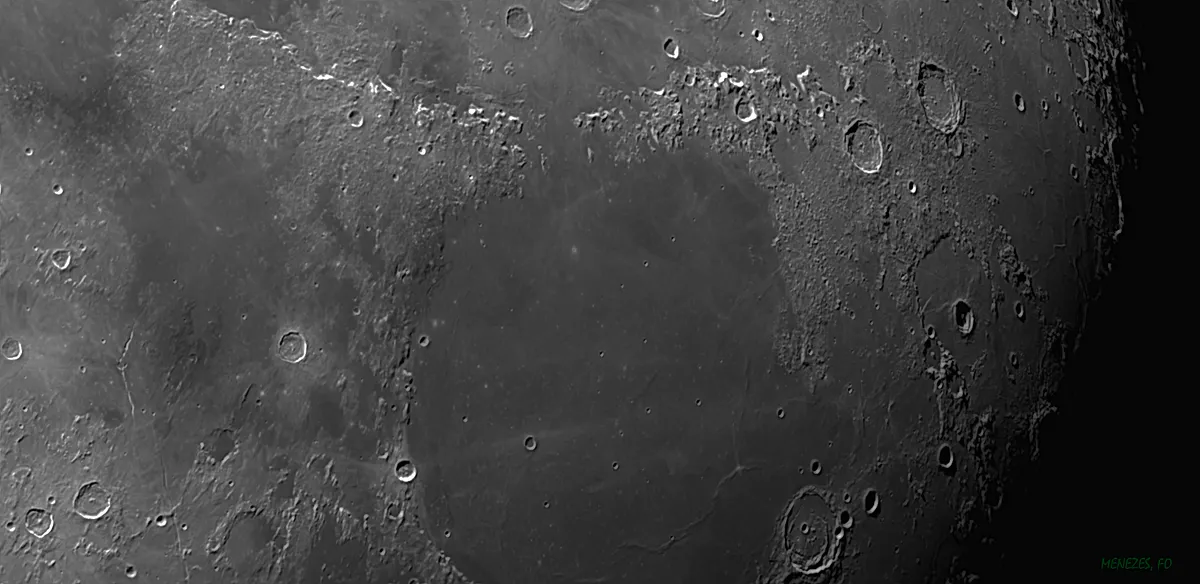A cheery look at the Moon, as we hone in on the feature known as Lacus Mortis, the Lake of Death!
It’s a distinctive feature that’s easily overlooked thanks to its position just to the north of Mare Serenitatis.
With a diameter of 650km and coated with dark lava, Mare Serenitatis is very easy to identify on the Moon.
Immediately to the north of it is a region where lava spills around various elevated highland regions.
This lava defines a 300km region called Lacus Somnorium, which translates as the Lake of Dreams.
Lacus Mortis borders Somnorium to the north, with 45km Plana and 43km Mason co-joined craters sitting on this border.
Read our complete guide to the lunar maria

Facts about Lacus Mortis
- Type: Lunar lake
- Size: 150km
- Longitude/latitude: 27.3° E, 45.1° N
- Age: Older than 3.9 billion years
- Best time to see: Five days after new Moon or four days after full Moon
- Minimum equipment: 10x binoculars
Crater Burg
As soon as your eye is drawn to the region, the most obvious feature you see first is the 40km crater Burg.
This is a young crater estimated to be less than 1.1 billion years old. Consequently, it appears sharp and well-defined.
It sits right in the middle of Lacus Mortis, surrounded by an impressive ejecta rampart which slopes from the edge of the crater’s rim down to the floor level of the lake below.
Burg is estimated to be around 3km deep.
Internally, Burg’s rim is cliff-like, sloping steeply down to a set of impressive terraces that are fascinating to observe under oblique illumination when the terminator is close.
Eventually the terraces give way to a flat inner floor that is mostly occupied by an impressive central mountain complex, the main peak rising to a height of around 1.2km.

Exploring the Moon's Lake of Death
Surrounding Burg is the lava surface of Lacus Mortis, the Moon's Lake of Death.
To the east, the surface is relatively flat save for a few lumps, bumps and generally small craterlets.
The surface to the west is a different matter altogether, containing many cracks and rilles.
Most impressive is Rimae Burg, the main rille running for 100km southwest to northeast and around 3km across at its widest point.
Follow the main rille towards the edge of Lacus Mortis and it’s possible to see that it continues for a short distance into the highland hills that define the lake’s boundary.
The region south of the main rille and in the southwest ‘corner’ of Lacus Mortis is interesting too, as it appears as if a section of the lake’s floor has subsided to create an escarpment feature.
This hits the edge of Lacus Mortis just to the west of the circular 14km crater Plana C.

The west and northwest surface of Lacus Mortis looks like some crazed animal has scratched it.
Small rilles that are considered part of Rimae Burg run in a chaotic manner across this area.
The most defining characteristic of Lacus Mortis is its unusual shape; it has a boundary that appears distinctly hexagonal.
The hexagonal sides to the northwest, west and southwest are obviously straight, the rest less so, possibly aided by the three distinctive edges tricking your brain into thinking some of the elevated bumps to the east complete the shape
The eastern border is quite open, eventually merging with the dark lava of Mare Frigoris, the Sea of Cold, to the north.
Have you observed or photographed the Lake of Death on the Moon? Let us know by emailing contactus@skyatnightmagazine.com
This guide appeared in the June 2024 issue of BBC Sky at Night Magazine

